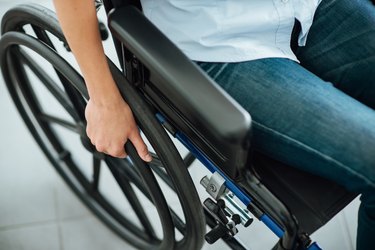
Muscle weakness can be alarming. The power and ability to move your legs stem from the interaction of two processes. These are the nerve signal that is sent to the muscles from the brain and passes via the spinal cord and the muscle's intrinsic power to contract.
Any interruption in this pathway in the lower limb can result in leg weakness. As such, leg weakness can be caused by a muscle disease or a nerve disease.
Video of the Day
Video of the Day
Read more: Leg Weakness Symptoms
Stroke and Muscle Weakness
Sudden onset leg weakness may be a very serious symptom as it could be a sign that a person is experiencing a stroke. Leg weakness is common in stroke because many stroke patients have brain damage in the areas controlling the nerve signal sent to the legs. This damage results in weakness or paresis, which means complete paralysis.
Sometimes this leg weakness is perceived as "heaviness" by the patient at the onset of the stroke. The patient experiences right-sided leg weakness if the stroke is on the left side, and the opposite is true. Stroke-caused leg weakness is also associated with weakness of the same-side arm.
Other signs of stroke include drooping on one side of the face, difficulty raising one arm and slurred or confused speech. Seek immediate medical attention if you suspect you are having a stroke.
Diabetes Nerve Damage
Leg weakness is one of the many complications people with diabetes may experience. Sometimes diabetics experience a form of nerve damage known as peripheral neuropathy. This nerve damage most often affects the lower limbs and causes leg weakness. Peripheral neuropathy also causes numbness. The National Diabetes Information Clearinghouse estimates that a third to a half of the people with diabetes have peripheral neuropathy.
Read more: Long-Term Effects of Peripheral Neuropathy
Familial Periodic Paralysis
A clinical entity known as familial periodic paralysis can cause leg weakness. Merck Manual describes familial periodic paralysis as a rare inherited condition that causes patients to experience episodes of severe limb weakness that resolve spontaneously.
Familial periodic paralysis is classified based on its relation to the amount of potassium in the patient's blood during the symptoms. A treatment plan will be set out for the patient according to whether she has normal, low or high potassium levels in her blood during the episode.
Nerve Cell Degeneration
Motor neuron disease is a group of disorders where the nerve cells controlling voluntary movement degenerate and die off. In some types, like primary lateral sclerosis (PLS), it is the nerve cells responsible for movement in the brain that die.
PLS is a progressive disease of unknown cause where there is specific damage in the nerve cells that control movement of the muscles of the leg, trunk and upper extremities. The weakness usually develops in that order.
Muscle Atrophy and Wasting
Muscle wasting, medically known as muscle atrophy, can also be a cause of leg weakness. An example of this is the weakness a fracture patient experiences after prolonged disuse of her leg placed in a cast. This type of weakness can be easily overcome with strength training and rehabilitation.
- National Diabetes Information Clearinghouse: Diabetic Neuropathy
- National Stroke Association: Act FAST: Use FAST to Remember the Warning Signs of a Stroke
- Merck Manual: Familial Periodic Paralysis
- National Institute of Neurological Disorders and Stroke: Primary Lateral Sclerosis Information Page
- Mayo Clinic: Primary Lateral Sclerosis (PLS)
Is this an emergency? If you are experiencing serious medical symptoms, please see the National Library of Medicine’s list of signs you need emergency medical attention or call 911.